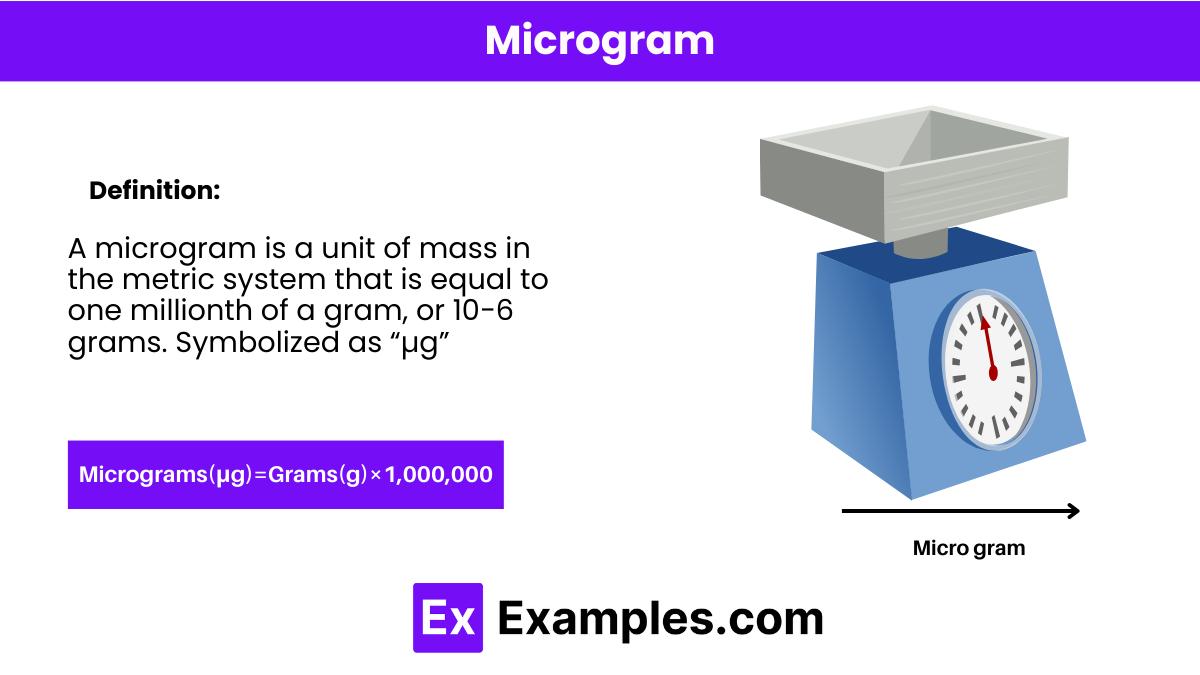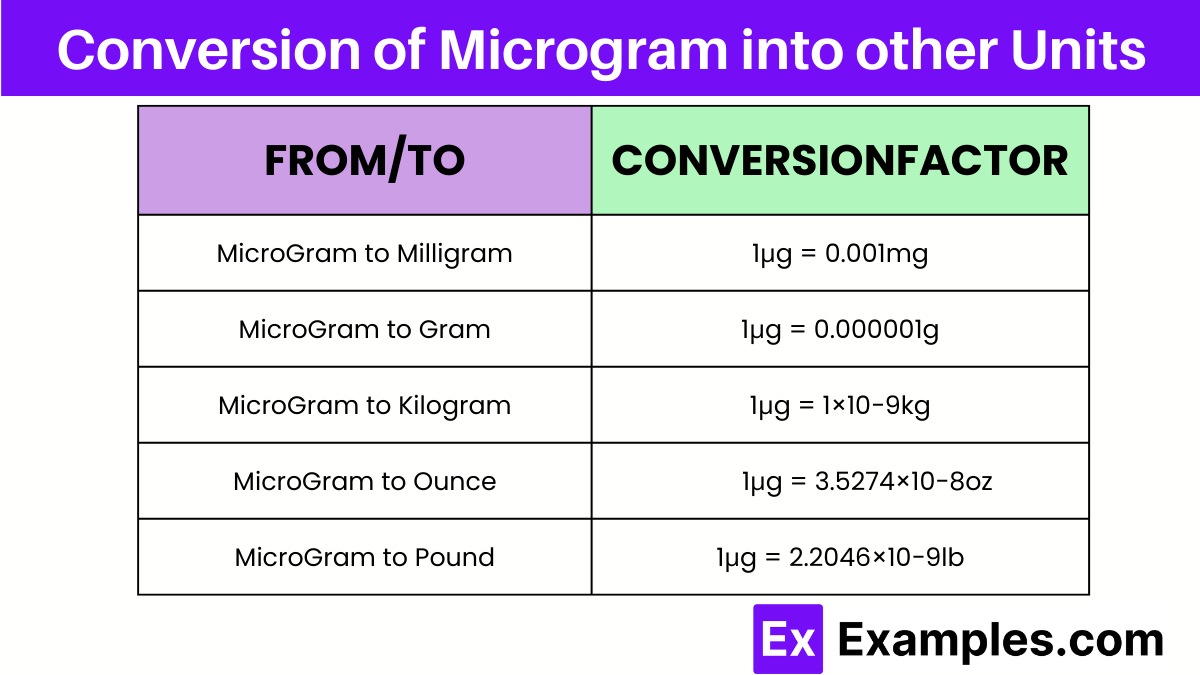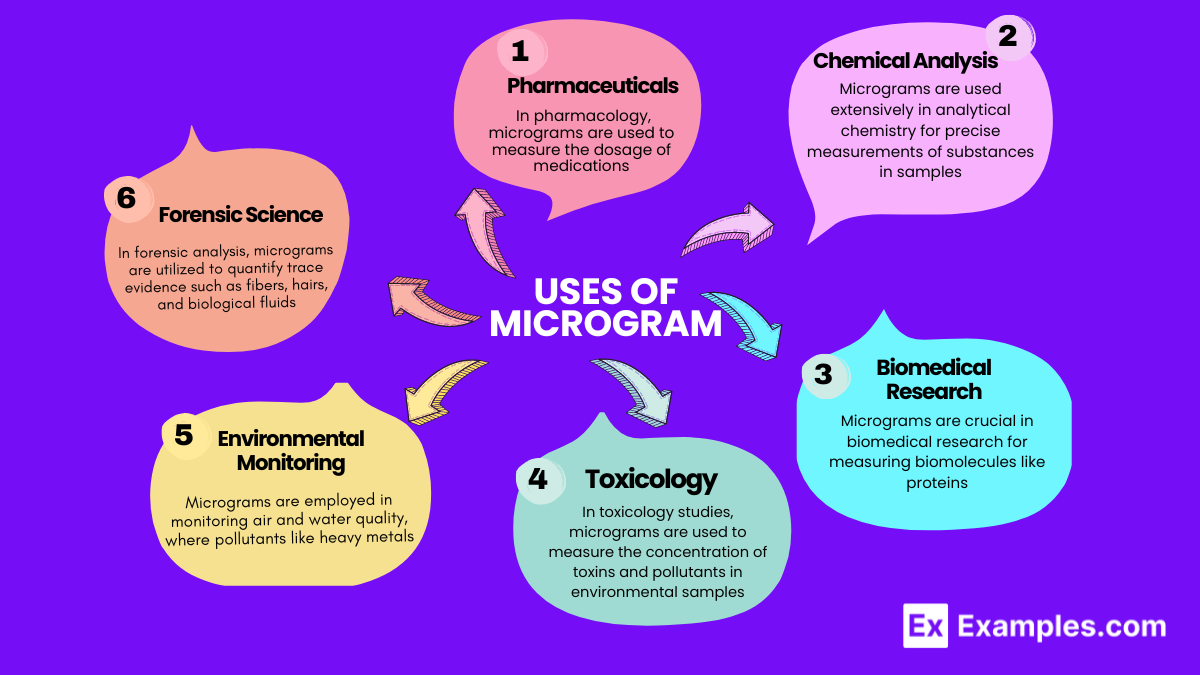What is the symbol for microgram?
mg
µg
ng
mcg


A microgram is a unit of mass in the metric system that is equal to one millionth of a gram, or 10−6
grams. Symbolized as “µg” (using the Greek letter mu followed by “g”), this unit is extensively used in chemistry, biology, and medicine because it allows for precise measurements of extremely small quantities.
Here is a table showing the SI (International System of Units) multiples for the microgram, which helps in converting it to larger or smaller units:
| Multiple | Prefix | Symbol | Micrograms (µg) |
|---|---|---|---|
| 10³ | Milligram | mg | 1,000 µg |
| 10⁰ | Microgram | µg | 1 µg |
| 10−³ | Nanogram | ng | 0.001 µg |
| 10−⁶ | Picogram | pg | 0.000001 µg |
| 10−⁹ | Femtogram | fg | 0.000000001 µg |
| 10−¹² | Attogram | ag | 0.000000000001 µg |
| 10−¹⁵ | Zeptogram | zg | 0.000000000000001 µg |
| 10−¹⁸ | Yoctogram | yg | 0.000000000000000001 µg |

| Unit | Symbol | Conversion |
|---|---|---|
| Milligram | mg | 1μg=0.001mg |
| Gram | g | 1μg=0.000001g |
| Kilogram | kg | 1μg=1×10−9kg |
| Ounce | oz | 1μg≈3.5274×10−8oz |
| Pound | lb | 1μg≈2.2046×10−9lb |
Since there are 1,000 micrograms in a milligram, dividing the number of micrograms by 1,000 gives the equivalent mass in milligrams.
There are 1,000,000 micrograms in a gram. Dividing the number of micrograms by 1,000,000 yields the mass in grams.
There are 1,000,000 micrograms in a gram. Dividing the number of micrograms by 1,000,000 yields the mass in grams.
There are approximately 28,349,523.1 micrograms in an ounce. Dividing the number of micrograms by 28,349,523.1 gives the mass in ounces.
There are approximately 453,592,370 micrograms in a pound. Dividing the number of micrograms by 453,592,370 gives the mass in pounds.

The microgram, abbreviated as “µg,” is a unit of mass in the metric system that is equal to one millionth of a gram. Despite its small size, the microgram plays a significant role in various fields due to its precision in measuring extremely small quantities. Here are some common uses of the microgram:
Pharmaceuticals: In pharmacology, micrograms are used to measure the dosage of medications, particularly for highly potent drugs where even a small deviation in dosage can have significant effects on patients.
Chemical Analysis: Micrograms are used extensively in analytical chemistry for precise measurements of substances in samples, such as contaminants in environmental samples or active ingredients in food products.
Biomedical Research: Micrograms are crucial in biomedical research for measuring biomolecules like proteins, DNA, and RNA, which are often present in very small quantities in biological samples.
Toxicology: In toxicology studies, micrograms are used to measure the concentration of toxins and pollutants in environmental samples, food, and biological tissues.
Environmental Monitoring: Micrograms are employed in monitoring air and water quality, where pollutants like heavy metals, pesticides, and industrial chemicals are measured in microgram concentrations to assess environmental health.
Forensic Science: In forensic analysis, micrograms are utilized to quantify trace evidence such as fibers, hairs, and biological fluids found at crime scenes, aiding in criminal investigations.
Manufacturing and Quality Control: Micrograms are used in manufacturing processes and quality control measures to ensure the accuracy and consistency of products, especially in industries such as electronics, pharmaceuticals, and food production.
Nanotechnology: In the field of nanotechnology, micrograms are used to measure the mass of nanoparticles, which are critical components in various applications such as drug delivery, electronics, and materials science.
Radiopharmaceuticals: In nuclear medicine, micrograms are used to measure the dosage of radiopharmaceuticals, which contain radioactive isotopes used for diagnostic imaging and cancer therapy.
Micrograms are used to measure very small quantities of mass, including active pharmaceutical ingredients, environmental pollutants, bio molecules, nano particles, and trace evidence in forensic analysis.
Text prompt
Add Tone
10 Examples of Public speaking
20 Examples of Gas lighting
What is the symbol for microgram?
mg
µg
ng
mcg
How many micrograms are in one milligram?
100
1000
10,000
1,000,000
If a tablet contains 500 µg of a substance, how many milligrams is this?
0.05 mg
0.5 mg
5 mg
50 mg
Convert 0.25 milligrams to micrograms.
250 µg
25 µg
2.5 µg
2500 µg
Which is larger: 1000 µg or 1 mg?
1000 µg
1 mg
They are equal
Cannot be determined
How many micrograms are in 0.1 milligrams?
1 µg
10 µg
100 µg
1000 µg
If a nutritional supplement contains 2000 µg of a vitamin, how many grams is this?
0.002 g
0.02 g
0.2 g
2 g
What is the equivalent of 0.5 grams in micrograms?
500 µg
5000 µg
50,000 µg
500,000 µg
A laboratory sample weighs 150 µg. How many nanograms (ng) is this?
1500 ng
15000 ng
150,000 ng
1,500,000 ng
Convert 0.005 grams to micrograms.
500 µg
5000 µg
50,000 µg
500,000 µg
Before you leave, take our quick quiz to enhance your learning!

